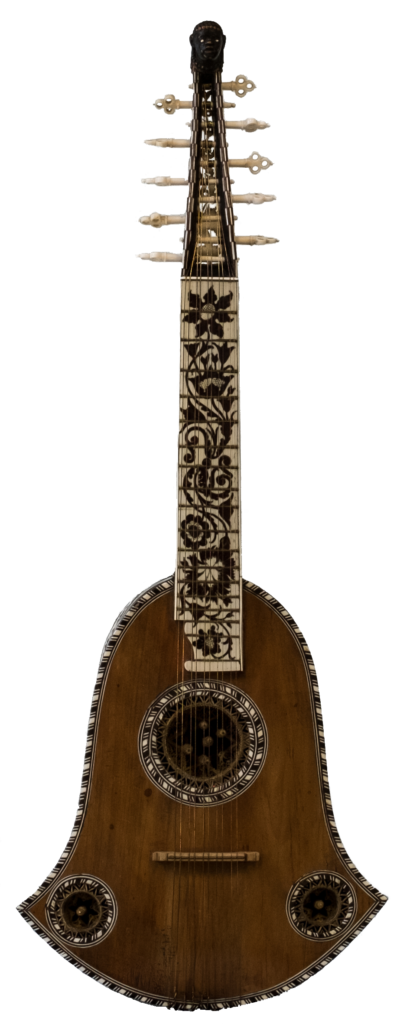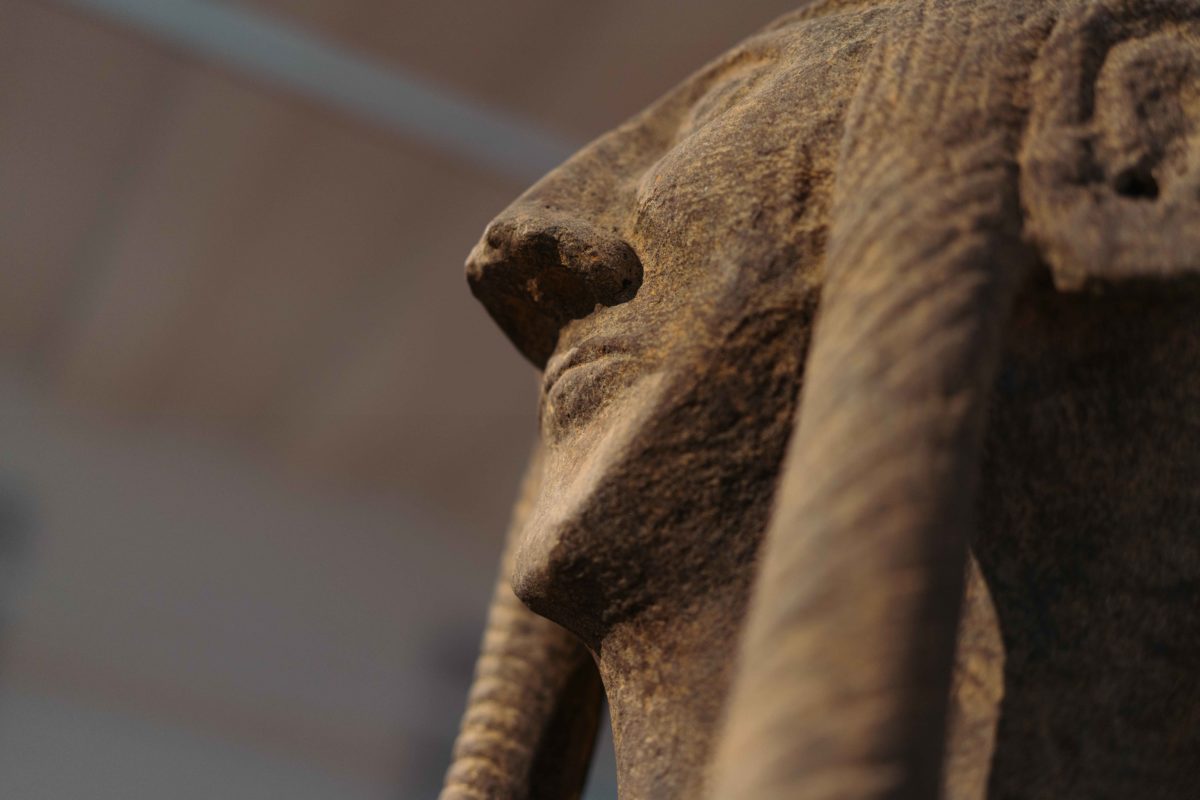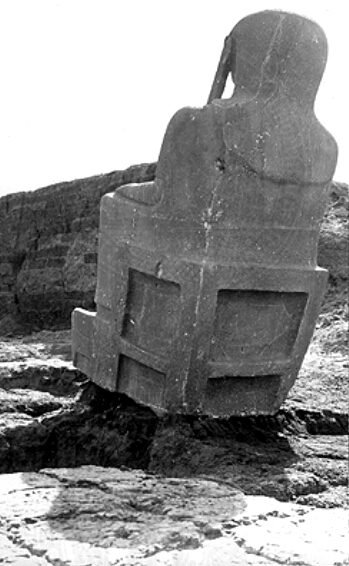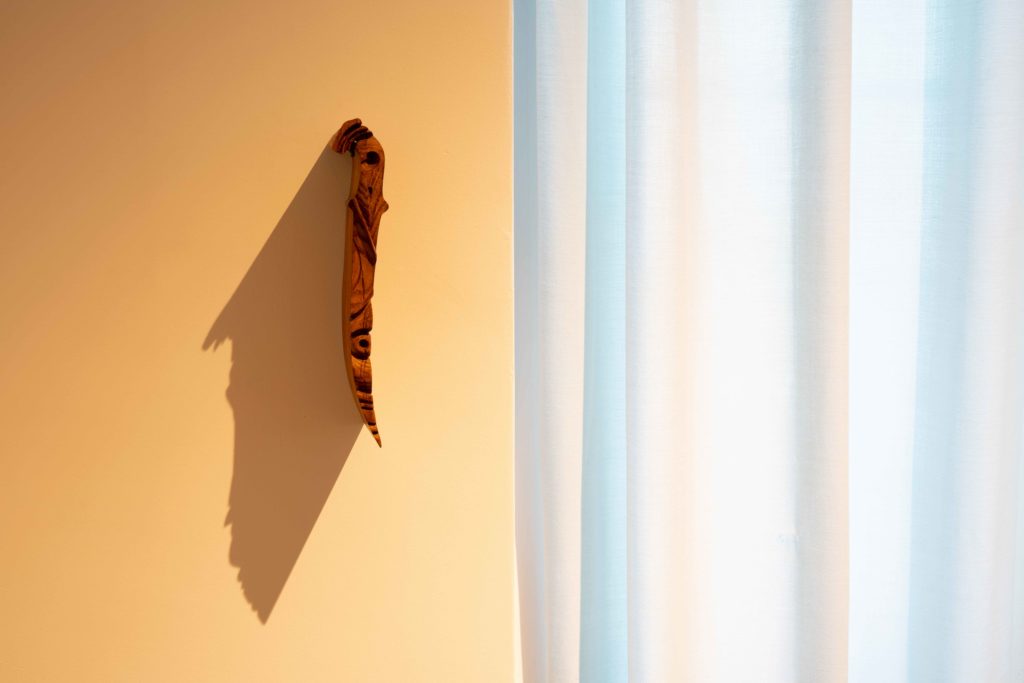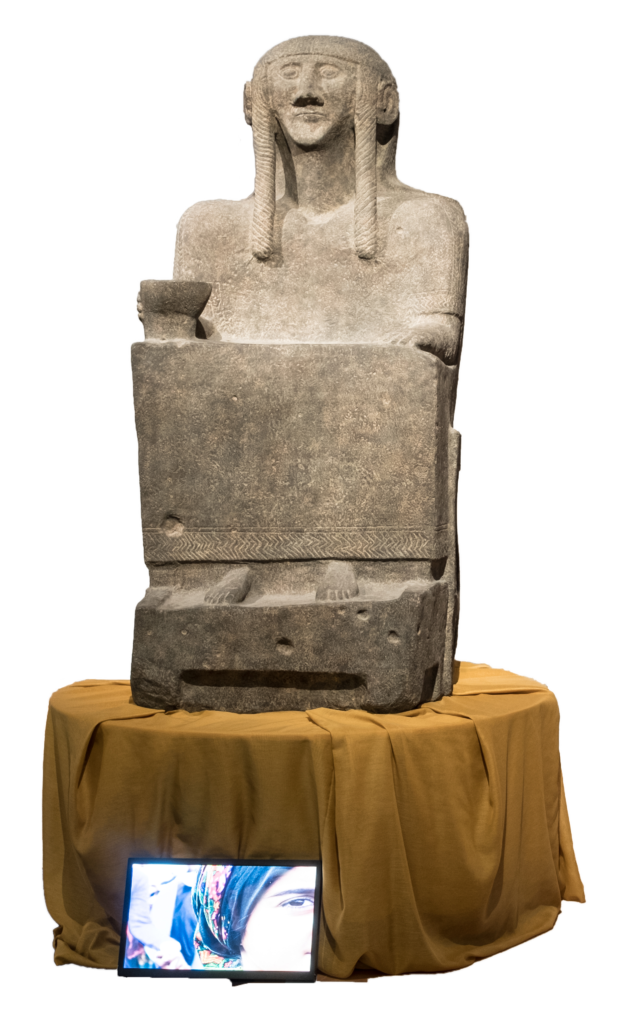







The Enthroned Goddess
Roger M. Buergel and Sophia Prinz / April 28, 2021
The woman strolled around the showcase, a stern look on her face. What caught her attention? The objects in there were fairly unspectacular: a comb made of rubber, a Meissen porcelain shard painted with chinoiserie, and an antique clay disc with a palmette motif. The showcase was located in a back room of the Museum of Arts and Crafts (MKG) in Hamburg. The public had no access to this space where the curators were doing experiments.
The experience is familiar to anyone who works in a museum (or curates exhibitions): You have an idea of how to arrange artworks or other artifacts in a way that is both surprising and revelatory. But as soon as you start to realize your idea and arrange the objects, the idea falls apart. The objects refute the curatorial vision.
For such experiments you need a back room, and a showcase to play around. This was the showcase the woman was contemplating.
We couldn´t ask her what she had on her mind. She had just arrived from Syria, she spoke Kurdish and Turkish, and we neither. She came with a group of women who live in Hamburg and are committed to the political recognition of a de facto autonomous region in northeastern Syria. This region is called “Rojava,” which in Kurdish means “west” or “sunset.”[1] The term has its pitfalls though, the women pointed out. They didn´t want to claim the territory solely for Kurds. Different ethnic and religious groups can coexist in the region in a peaceful manner. This would require local self-government, but above all the political empowerment of women from the different communities.[2]
Finally, one of the Rojava activists translated our question. The Kurdish woman gave a more philosophical answer. She was pondering about cultural heritage over in Syria and here in Germany. Did we know that the YPG units are entrusted with the protection of archaeological sites?[3] No, we didn´t; we were only aware of the iconoclastic excesses of the “Islamic State”. The Kurdish forces had to keep quiet about all those things, she told us. But today, and no longer deployed in the war zone, she started to ask herself what it actually means to save, preserve, store, and display objects from yesteryear.
This is a profound question, and there is no simple answer to it. Raising it in the midst of a European museum of decorative arts that, as a child of the 19th century world exhibitions, sits on an almost unmanageable mountain of stuff (whether it is sublime in nature or completely irrelevant), didn´t make it any easier.[4]
The group of Kurdish activists did not stray into the museum by chance. They were invited to participate in “Mobile Worlds”, an exhibition which aimed to build a bridge between the transcultural reality of post-migrant Germany and a museum collection in which many objects have a prismatic character and don´t fit into categories like “Islam,” “modernity,” “Near East,” or “antiquity”.[5]
Initially, the activists toyed with the idea to contextualize the Mesopotamian objects in the museum collection. They prepared a small archive of images and texts to comment on the current situation in northern Syria. While we looked at this archive in the aforementioned back room, however, one thing became clear: documentary evidence, which works well in the normal world, turns into conceptual art as soon as it enters the museum space. The material acquires an aura, and the activists didn’t want that, and neither did we. A different approach was needed, one that relied on the force inherent in the museum objects.
The most prominent object that came to mind was the so-called “Throning Goddess” in Berlin. The name is purely fictitious, since almost nothing is known about this tomb figure made of basalt, which wears braids and dates back at least 3000 years. The “Goddess” was discovered and excavated at the beginning of the 20th century in northern Syria, at Tell Halaf, a hill near the present-day Turkish-Syrian border. The excavation was overseen by a German diplomat and amateur archaeologist named Max von Oppenheim, who at that time supplied the German Empire with information about the Orient from his office in Cairo. Because of his Jewish background, Oppenheim was denied an official career in the anti-Semitic tinted Diplomatic Service. But that did not stop him from undertaking less official missions.
As part of such a mission, in 1899 Oppenheim explored a possible route for the “Baghdad Railway” – a massive infrastructure project that was to connect Berlin with (what was then) Constantinople, Aleppo, Baghdad and finally Basra by means of a railroad line. (The geostrategic importance of such a rail line, which would have given the Germans access to the Red Sea, can hardly be overestimated. In addition to transporting troops and raw materials across Europe and the Middle East, the German presence on the Red Sea would have acutely threatened British control of their colonies).[6]
During his fact-finding mission, Oppenheim’s attention was drawn to Tell Halaf, and in 1911 he began uncovering its archaeological treasures on a grand scale. The First World War initially interrupted the excavations. Oppenheim went back to Cairo, to the “News Agency for the Orient,” and pursued the ambitious plan of inciting the Muslim population to a jihad against the British (in Egypt) and the Russians (in the Caucasus).[7] Then in the mid-1920s, Syria was by now a French mandate, he was able to continue the excavations at Tell Halaf. Along with other sculptures and architectural fragments, the “Enthroned Goddess” migrated to Berlin. There, the state museums refused to include the finds in their collection, and so Oppenheim decided to found his own institution: the Tell Halaf Museum. Set up in an empty factory building, this museum was a highly idiosyncratic undertaking (and anticipated artistic museum projects such as those of Marcel Broodthaers, Claes Oldenburg, or Allan Sekula). Visitors like Carl Einstein and Samuel Beckett appreciated the Mesopotamian Gesamtkunstwerk in the middle of Berlin, while Agatha Christie was rather bored during her museum tour. In her diary, she also mocked Oppenheim’s fetishistic behavior toward the basalt goddess, whom he adored as “my beautiful Venus.”[8]
The Kurdish activists also cared about the “Goddess,” albeit for different reasons. In their view, the monument represented female power (and the victory over the self-proclaimed holy warriors of IS). The question came up if it would be possible to show the “Goddess” in “Mobile Worlds” – alongside images of female fighters and political leaders.
Fascinatingly, the activists took the age-old monuments as role models. The “Seated Couple,” for example, another of Oppenheim’s finds, inspired gender politics in northern Syria (the constitution of the autonomous region stipulates that every government office must be held by a dual head, a man and a woman). The archaeological artifacts were therefore more than mere “cultural heritage.” They were harbingers of political change and pointed to a future that would spring from the past.
Clearly, such a treatment of archaeological artifacts upsets Western museum standards. I beg your pardon, an antiquity that comes from the future? It was also obvious that the artifacts were to take part in a feminist fantasy. No one has a clue what the “Goddess” or the “Seated Couple” once meant. It is precisely this mystery, however, that allowed the artifacts to acquire a contemporary meaning.
The Tell Halaf Museum was completely destroyed in a bombing raid in 1943. While the phosphorus heat left the volcanic basalt reasonably intact, the extinguishing water caused the sculptures to burst. Oppenheim’s helpers at least managed to salvage the thousands of pieces of rock and store them in the depot of the Pergamon Museum. Here they slept away the GDR, only to be brought back to light in 2001. The objects were reconstructed and then restored in an elaborate manner and, finally, the State Museums of Berlin presented the Mesopotamian artifacts under the title “The Rescued Gods from the Palace of Tell Halaf.”[9] The restoration team had made no attempt to cover up the massive damage done to the objects. Today, the artifacts seem all the more pathetic, although the pathos attaches less to the artifacts themselves than to the heroic, even national act of restoration. The “Goddess” remains spellbound in the Berlin museum cosmos.
A de facto appropriation of the “Goddess” by the Rojava activists was out of the question. The topic of restitution wasn´t even brought up, as the war is still raging, with the archaeological sites now being attacked by the Turkish army. Fortunately, however, Oppenheim was a thorough man who had plaster casts made of the finds while they were still on site. The cast of the “Goddess”, which is now kept in the plaster molding workshop of the Berlin Museums, shows the sculpture in its original condition – before the destruction. In addition, the casts are true virtuoso pieces, which also reproduce the feel of the sculpture, its basalt surface deceptively real through a layer of sand. There was a consensus among the Rojava activists that this cast of the undamaged “Goddess” was much closer to the feminist cause than the pathetic rubble woman from the Museum of the Ancient Near East. In fact, the “Goddess” developed into a Photo Opp not only for the Kurdish-Syrian community in Hamburg.
[1] In 2017/18, the Autonomous Administration of Northern and Eastern Syria controlled an area of approximately 50,000 km/2, home to some 4.6 million people of various ethnicities, many of them refugees from the Syrian civil war. Following the invasion of the region by the Turkish military (2018/19), with the simultaneous withdrawal of U.S. forces, the autonomous administration, including its combat units, was forced to pact with the Syrian government.
[2] The Hamburg activists who worked on “Mobile Worlds” belong to the Foundation of Free Women in Syria (WJAS).
[3] The YPG form the de facto army in northern Syria and were part of the Syrian Democratic Forces (DKS) established by the US in the fight against IS.
[4] Museums of decorative arts, first and foremost today’s Victoria & Albert Museum in London, are not only ideologically attached to world exhibitions. The founding director of the Hamburg Museum für Kunst und Gewerbe, Justus Brinckmann, went on a shopping spree at the Vienna (1873) and Paris World’s Fairs.
[5] The exhibition “Mobile Worlds” took place from April to October 2018 at the Hamburg Museum für Kunst und Gewerbe (MKG). It was part of a joint project with the universities Viadrina (Frankfurt a.d.Oder) and Johann Wolfgang Goethe University (Frankfurt a.M.). Many chapters of this exhibition had previously been developed at the Johann Jacobs Museum (Zurich).
[6] The “Baghdad Railway” project was pursued from 1910-40, initially with technological and financial support from the German Empire, which had a heightened interest in the Mesopotamian oil fields on the eve of World War I. See Sean McMeekin, “The Berlin-Baghdad Express: The Ottoman Empire and Germany’s Bid for World Power,” 1898-1918, London (Penguin) 2011.
[7] See Stefan M. Kreutzer, “Dschihad für den deutschen Kaiser: Max von Oppenheim und die Neuordnung des Orients (1914-1918),” Graz (Ares).
[8] Agatha Christie visited the Tell Halaf Museum accompanied by her husband, archaeologist Max Mallowan.
[9] See “Die geretteten Götter aus dem Palast vom Tell Halaf,” edited by the Vorderasiatisches Museum der Staatlichen Museen zu Berlin on the occasion of the 2011 exhibition of the same name at the Pergamon Museum, Regensburg (Verlag Schnell & Steiner) 2011.



